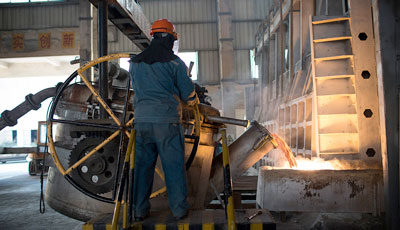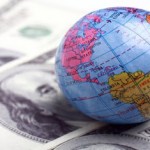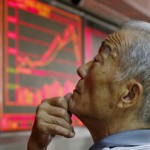The Abundant Commodity That’s Becoming Harder to Find

Bauxite, one of the most common ores in the earth’s crust, is growing scarce.
It’s been 10 months since Indonesia banned exports of bauxite, used to extract aluminum, in a bid to transform its mining industry, and the global market is still struggling to replace the lost supply. Bauxite prices are up about 15 percent and aluminum is rallying the most since 2009, driving up costs for importers including the world’s top buyer, China. A global surplus last year has become a shortage in 2014 that Citigroup Inc. says will last three years.
Indonesia, the world’s third-largest supplier, halted shipments of raw ore, including nickel and copper, in a bet that sacrificing jobs short-term would spur investment in exports with more value and profit. There are six projects under way to turn bauxite into alumina, which is used to make aluminum. They include a $1.2 billion venture on the coast of Borneo with China Hongqiao Group Ltd. Several of them won’t start producing until 2017, forcing buyers of aluminum used in everything from cans to aircraft to use more inventories.
“We’re definitely bullish about bauxite for 2015,” Ivan Szpakowski, a Citigroup analyst in Hong Kong, said by telephone on Nov. 11. “The main factor in the bauxite and alumina market is the Indonesian ban. It’s going to take a while for any replacement supply to come through.”
Bauxite Outlook
Bauxite delivered to China’s Shandong province, the top importing region, may climb to $80 a metric ton by the end of 2015 from $60, Goldman Sachs Group Inc. said in a report Nov. 5. Citigroup estimated prices were around $52 before the ban, which led to closed mines and layoffs of 40,000 workers. Goldman Sachs said alumina may advance 12 percent next year, while Morgan Stanley listed it as a top metals pick.
Global output of bauxite will trail consumption by about 6.3 million tons this year, compared with a surplus of 49.3 million tons in 2013, according to Citigroup. China may face a shortfall of 10 million to 15 million tons next year, producer Alumina Ltd. (AWC) said last month. The Melbourne-based company is a partner with New York-based aluminum producer Alcoa Inc. (AA) in Alcoa World Alumina & Chemicals, the largest alumina producer.
Indonesia is an archipelago of more than 17,000 islands, with most of its bauxite reserves located on Borneo. Before the ban, the country represented 10 percent to 15 percent of world supply and accounted for half of what was consumed in China, the largest aluminum producer, Goldman Sachs estimates.
Aluminum Prices
With the cost of supplying refined metal increasing, Goldman says prices may rise for aluminum, which climbed 14 percent this year to $2,059 a ton on the London Metal Exchange, the most after nickel. The New York bank says its 12-month forecast is $2,100, with risks skewed to the upside.
Aluminum is the most abundant metallic element in the earth’s crust after silicon, the U.S. Geological Survey says. It takes some four to seven tons of bauxite to make one ton of aluminum. About a third of the cost of aluminum comes from alumina, while bauxite contributes less than 10 percent, says Paul Gait, an analyst at Sanford C. Bernstein Ltd. in London.
As other countries start ramping up output, some argue that the impact of less Indonesian ore on prices may be limited in coming years. Bauxite exports from Australia, which became the largest supplier to China in March, will climb 11 percent to 16.8 million tons in 2014-2015 from a year earlier, the Canberra-based Bureau of Resources and Energy Economics forecast in September.
Relaxing Ban
Slowing global economic growth, including in China, could also curb demand for aluminum. Global inventories reached a three-year high of 2.519 million tons in October, International Aluminum Institute data show.
While President Joko Widodo reaffirmed his commitment to the ban on all Indonesian ore this month, the impact of lost mining jobs and slower growth may force the government to ease its limits on trade. Widodo, who took office on Oct. 20, inherited the policy from his predecessor, Susilo Bambang Yudhoyono. Andrew Wood, group executive of strategy and development at Alumina, told an industry conference in Singapore last month that easing the ban remains a possibility.
The mining industry shrank 0.25 percent in the first nine months of 2014 as Indonesia’s economy grew just 5.01 percent in the third quarter, the slowest pace since the global financial crisis in 2009.
Slumping Supply
For now, China’s bauxite stockpiles are being depleted. Total imports fell 50 percent to 31 million tons in the first 10 months of the year from 61 million a year earlier, customs data show. Imports will drop to 37 million tons this year from 72 million tons in 2013, according to Norsk Hydro ASA, an Oslo-based aluminum producer. Stockpiles may last six months, Commonwealth Bank of Australia said in an Oct. 29 report.
On the coast of Borneo, PT Well Harvest Winning Alumina Refinery, a joint venture that includes China Hongqiao Group (1378), Indonesia’s Harita Group and two partners, is transforming a swamp area into a complex that will employ about 3,000 people when it starts operation in 2016.
The refinery, which includes a new jetty and a power plant burning local coal, will have a capacity to produce 2 million tons of smelter-grade alumina, Song Jing, the production manager, said in an interview at the site in Kendawangan district, West Kalimantan. The first phase for 1 million tons may be finished by the end of 2015, with output starting in early 2016 using bauxite from Harita’s mines, he said.
Other projects are taking shape. In the north of Kalimantan, PT Aneka Tambang is set to start commercial production at a 300,000-ton chemical-grade alumina refinery in Tayan by yearend, Secretary Tri Hartono said by telephone Nov. 11. Including Well Harvest and Aneka Tambang, there are six alumina ventures expected to be built by 2017, the energy ministry estimated this month.
Until those refiners are operational, Indonesia’s dormant bauxite mines may keep supplies tight for the rest of the world.
Source: Bloomberg – The Abundant Commodity That’s Becoming Harder to Find





























